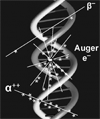Therapeutic radionuclides: biophysical and radiobiologic principles
- PMID: 18662557
- PMCID: PMC2584872
- DOI: 10.1053/j.semnuclmed.2008.05.002
Therapeutic radionuclides: biophysical and radiobiologic principles
Abstract
Although the general radiobiologic principles underlying external beam therapy and radionuclide therapy are the same, there are significant differences in the biophysical and radiobiologic effects between the 2 types of radiation. In addition to the emission of particulate radiation, targeted radionuclide therapy is characterized by (1) extended exposures and, usually, declining dose rates; (2) nonuniformities in the distribution of radioactivity and, thus, absorbed dose; and (3) particles of varying ionization density and, hence, quality. This review explores the special features that distinguish the biologic effects consequent to the traversal of charged particles through mammalian cells. It also highlights what has been learned when these radionuclides and radiotargeting pharmaceuticals are used to treat cancers.
Figures







References
-
- Walicka MA, Vaidyanathan G, Zalutsky MR, Adelstein SJ, Kassis AI. Survival and DNA damage in Chinese hamster V79 cells exposed to alpha particles emitted by DNA-incorporated astatine-211. Radiat Res. 1998;150:263–268. - PubMed
-
- Goddu SM, Howell RW, Rao DV. Cellular dosimetry: absorbed fractions for monoenergetic electron and alpha particle sources and S-values for radionuclides uniformly distributed in different cell compartments. J Nucl Med. 1994;35:303–316. - PubMed
-
- Kassis AI. The amazing world of Auger electrons. Int J Radiat Biol. 2004;80:789–803. - PubMed
-
- Cole A. Absorption of 20-eV to 50,000-eV electron beams in air and plastic. Radiat Res. 1969;38:7–33. - PubMed
-
- Kassis AI, Adelstein SJ, Haydock C, Sastry KSR. Radiotoxicity of 75Se and 35S: theory and application to a cellular model. Radiat Res. 1980;84:407–425. - PubMed
Publication types
MeSH terms
Substances
Grants and funding
LinkOut - more resources
Full Text Sources
Other Literature Sources
Medical

